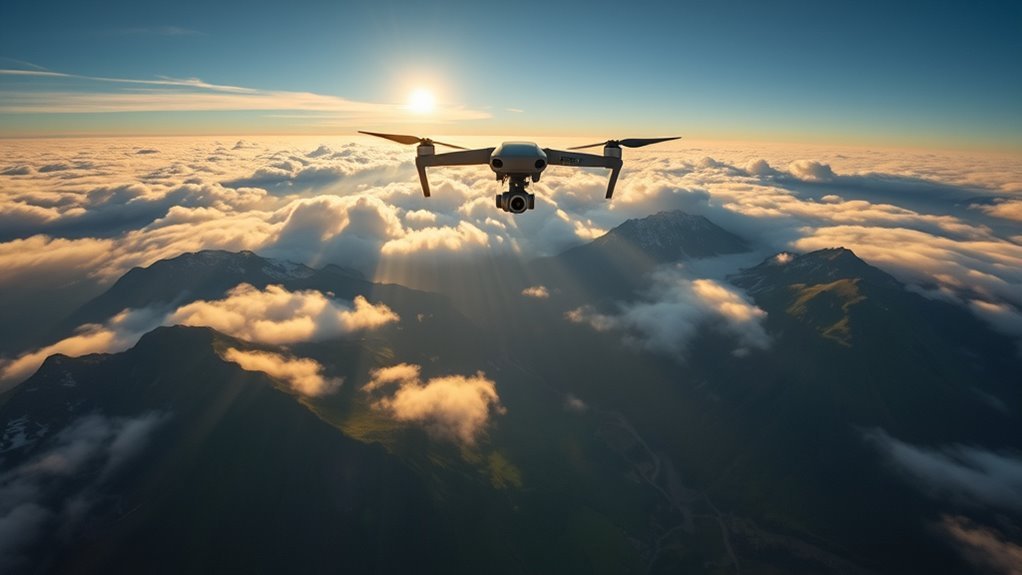The highest altitude a drone can operate often depends on its type and regulations. Recreational drones are typically limited to 400 feet above ground level, while commercial models may reach 15,000 feet with proper permits. Factors like drone design, weight, and battery capacity can also impact maximum altitude. Additionally, airspace classifications can impose further restrictions. Keeping track of these elements can enhance your flying experience, leading to important insights about drone operations.
Understanding Drone Altitude Regulations

When operating a drone, it’s crucial to understand the altitude regulations that govern your flights, as these rules can vary considerably by location and purpose. Altitude restrictions are typically set by national aviation authorities, often limiting recreational drones to 400 feet above ground level. It’s essential to check local drone regulations, as certain areas, like near airports or military zones, impose stricter limits. Additionally, altitude restrictions may differ depending on whether you’re flying for recreational or commercial purposes, with the latter often requiring permits for higher altitudes. Staying informed about these regulations not only guarantees your compliance but also maximizes your freedom to explore the skies safely and responsibly. Always verify the latest updates to avoid potential legal repercussions.
Factors Affecting Maximum Altitude

Although various factors influence the maximum altitude a drone can reach, the most significant include drone design, weight, battery capacity, and environmental conditions. Understanding these elements helps you optimize altitude performance and enhance drone capabilities. Additionally, maintenance practices play a crucial role in ensuring that drones operate effectively at higher altitudes by keeping components in optimal condition. Robust engineering ensures that drones can maintain peak performance even under challenging conditions.
| Factor | Impact on Altitude Performance | Considerations |
|---|---|---|
| Drone Design | Aerodynamics affect lift | Frame material, size |
| Weight | Heavier drones struggle | Payload management |
| Battery Capacity | Determines flight time | Battery type, charge |
| Environmental Conditions | Wind and temperature affect stability | Altitude weather |
| Propulsion System | Motor power affects ascent | Motor efficiency |
Maximum Altitude Limits for Different Drone Models

Understanding the factors that influence a drone’s maximum altitude performance allows for a clearer comparison of the altitude limits across various drone models. Different drones have varying specifications that dictate their ability to ascend. For instance, consumer drones typically max out around 400 feet, adhering to safety regulations, while high-end racing drones can reach altitudes of over 1,000 feet due to their enhanced power-to-weight ratios and advanced propulsion systems. Professional-grade drones, designed for aerial photography or surveying, often have altitude limits defined by their specific applications, with some models capable of reaching 15,000 feet or more. By examining these drone specifications, you can better understand the altitude performance you can expect from each model, allowing for informed choices based on your needs.
The Role of Airspace Classifications
As you navigate the complexities of drone operation, recognizing the role of airspace classifications becomes essential for safe and compliant flying. The FAA defines various airspace types, each with specific altitude restrictions that dictate where you can operate your drone. For instance, Class G airspace allows for greater freedom, often free from altitude limitations, while Class B airspace imposes strict height limits due to proximity to major airports. Understanding these classifications not only helps you avoid violations but also enhances your flying experience. By staying informed about airspace types and their altitude restrictions, you can maximize your drone’s capabilities while ensuring safety and legality in your operations. Awareness of these factors is vital for responsible drone enthusiasts.
Safety Considerations for High-Altitude Flights
Maneuvering high-altitude flights with your drone requires a keen awareness of safety considerations. First, be mindful of high altitude safety regulations to prevent collisions with manned aircraft. Always check local airspace requirements and avoid restricted zones. Pre-flight checks are vital, ensuring your drone’s battery life and signal strength are adequate for high-altitude operations. Additionally, understanding frequency bands used by drones can help you select the best communication channels for maintaining control at altitude. Establish emergency protocols before launching; know how to regain control should your drone lose connection or encounter adverse weather. It’s essential to maintain visual line-of-sight whenever possible, even at altitude. Finally, consider utilizing altitude limits on your drone to avoid unintentional breaches of airspace. By prioritizing these safety measures, you can enjoy the freedom of high-altitude flight while minimizing risks. Additionally, leveraging enhanced stabilization technology can help counter challenges posed by uneven landscapes and high winds.
Frequently Asked Questions
Can Drones Fly Above the Maximum Altitude Limit Legally?
Drones can’t legally fly above maximum altitude limits due to strict altitude regulations. Ignoring these legal restrictions could lead to penalties. It’s essential to understand and adhere to the regulations for safe, responsible drone operation.
What Are the Consequences of Flying a Drone Too High?
If you fly your drone too high, you risk collisions with manned aircraft, legal penalties, and loss of drone safety. Maintaining altitude awareness guarantees you operate within regulations, preserving both your freedom and safety in the skies.
Do Weather Conditions Impact a Drone’s Altitude Capabilities?
Like Icarus soaring too close to the sun, your drone’s altitude performance hinges on weather factors. Wind, temperature, and humidity can drastically impact its capabilities, limiting your freedom to explore the skies effectively.
Can Modifications Increase a Drone’s Altitude Limits?
Yes, altitude modifications can enhance a drone’s performance. By optimizing components like propellers and motors, you can potentially increase its altitude limits, allowing for greater operational flexibility and the freedom to explore higher airspace efficiently.
Are There Altitude Limits for Drone Racing Events?
Imagine soaring like an eagle, yet in drone racing, altitude regulations tether your ascent. These limits guarantee safety and fairness, keeping competitors grounded while traversing the skies, balancing freedom with the rules of the aerial arena.

